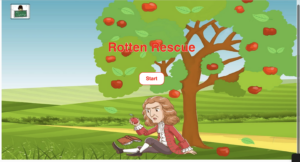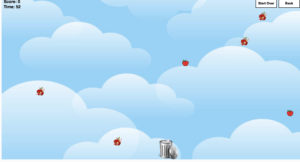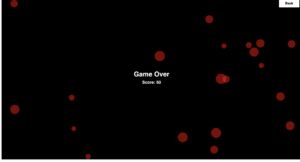Concept:
The initial concept of this game was to be something different and unusual of the games that we already see where the “good” item is collected and the bad item is supposed to be avoided. But since I am using apples, I decided to relate this a bit to physics and the Isaac Newton apple incident that led to him discovering gravity… This makes the game more interesting and leaves a chance to improve it and make it a bit educational as well.
Full screen display of the game: https://editor.p5js.org/jana_mohsen/full/jEKauH5OR
Game:
Design:
In this game, players maneuver a trash can to catch rotten apples while avoiding the clean ones. The game is structured into several screens: an introduction, instructions, the main game, and a game-over sequence. There are multiple classes used like the Apple Class that regulates both the types of apples, the Trashcan Class which ensures the moevments of the trashcan on the horizontal axis and lastly, the Bubbles Class which is just used to regulate the number, size and speed of apples that are being displayed in the game over page.
The most important part of the code are the functions for each page of the game. The (displayIntro()) function displays the introduction page, which greets with the player with the game title and a start button. Then the second function: (displayInstructions()) teaches the player the “how-to-play” guidelines, respectively, with options to start or proceed to the game. It also allows the player to input the game before starting to play.
During the active game phase, apples of two types—“clean” and “rotten”—descend from the screen’s top. Players control the trash can, moving it left or right to catch rotten apples while avoiding the clean ones. The game keeps score and includes a countdown timer, enhancing the challenge. It manages the player’s interaction with the game through the trash can’s movements when they press keys, allowing the player to move the trash can left or right to catch falling apples, facilitated by the trashCan.display() and trashCan.move() methods.
Within its cycle, runGame() also takes charge of spawning new apples at fixed intervals, alternating between “clean” and “rotten” types, which are then added to an array for tracking. As time progresses, it continuously updates the player’s score by incrementing by 10 based on the type of apples caught and counts down the game timer, implementing a sense of urgency and challenge. The function diligently checks for end-game scenarios, such as the depletion of the timer or accumulation of too many clean apples, transitioning to a game-over state if any conditions are met. Moreover, within this loop, each apple’s position is updated, and its status is checked to determine if it has been successfully caught by the trash can or missed. Apples that are caught or fall off the screen are removed from the gameplay loop, ensuring the game’s state remains current.
When the game ends, either from catching more than 2 clean apples or because the timer ended, the game trasitions to a game over page where the players final score appears. Finally, the game employs a “bubble” effect on the game-over screen for visual appeal, where bubbles generated by the createBubbles() function move around the screen.
Challenging part:
The most interesting and challenging part of this game is creating the logic behind it. The rest is just assembling buttons, images and creating a nice aesthetic to the game.
function runGame() {
inputName.hide();
// Set Instruction.jpeg as the background
image(imgInstructions, 0, 0, width, height);
trashCan.display();
trashCan.move();
// Displays score and timer at the top left
displayScore();
// Logic for apples falling and being collected or missed
if (frameCount % 60 === 0) {
let type = random(['clean', 'dirty']);
apples.push(new Apple(type));
}
for (let i = apples.length - 1; i >= 0; i--) {
apples[i].move();
apples[i].display();
if (apples[i].y + apples[i].size > trashCan.y && apples[i].x > trashCan.x && apples[i].x < trashCan.x + trashCan.width) {
if (apples[i].type === 'dirty') {
score += 10;
} else {
redApplesCollected++;
if (redApplesCollected >= 3) {
currentPage = 'gameOver';
// Create bubbles for game over animation
createBubbles(20);
break;
}
}
// Remove collected or missed apple from array
apples.splice(i, 1);
} else if (apples[i].y > height) {
// Remove apple that falls off screen
apples.splice(i, 1);
}
}
// Timer countdown and check for game over condition
if (frameCount % 60 === 0 && gameTimer > 0) {
gameTimer--;
} else if (gameTimer === 0) {
currentPage = 'gameOver'; // Time's up
createBubbles(20); // Prepare game over screen
}
// Drawing and positioning Start Over and Back buttons
drawGameButtons();
}
The main issue of the project was developing the logic for this game, which proved to be the most major challenge during development. The complex interactions between the various components of the game—like the falling apples, the moving garbage can, and the score system—needed to be carefully thought out and executed. To guarantee seamless gaming and compliance with the game’s regulations, the logic controlling the game’s behavior has to be strong and effective. In order to guarantee precise and reliable performance, handling edge circumstances such as identifying collisions between apples and the trash can or controlling the game’s timing required careful coding and testing.
The code consists of many parts. The trashcan is displayed and moved by the function in response to the players key press. It also shows the amount of game time left and updates the player’s score. The reasoning behind the apples falling is the most important aspect of the function. At regular intervals, it produces red apples, randomly classifying them as normal or rotten. The apple array is then iterated over, with each apple being moved and displayed as the program looks for collisions with the trash can. If an apple is detected, the apple is taken out of the array and the score is changed appropriately. On the other hand, if an apple is missed, it is removed, and if the player has missed too many and it is rotten, the game ends. Lastly, the function controls the game timer, which starts a countdown every second and enters the game over state when the allotted time is up. It also draws and arranges buttons so that you can go back to the main menu or resume the game. In order to create a compelling gaming experience, this function coordinates the interplay between game objects and player input, encapsulating the fundamental gameplay logic.
Limitations and improvements:
The game can have better ways to make it a bit competitive like adding a high score board to show the scores of all the players. Moreover, the amount of apples is random so it might be unfair between players since one can have 10 rotten apples and another only 5. All of these issues are seen as parts to be improved to make the game more appealing and competitive.
Game visuals:
Instructions page:
Game page:
Game over page:




